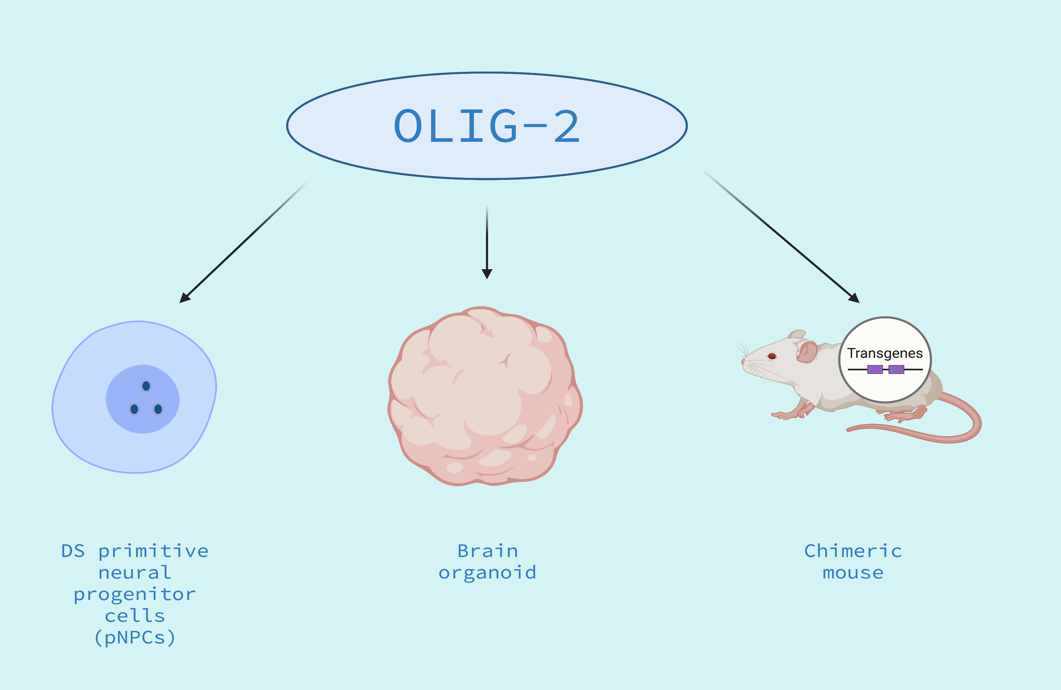Promising models to study Down syndrome
Abstract
Organoids and chimeric mice: a possible reliable pattern to develop personalized prenatal therapy?
Down syndrome is a pathology caused by chromosome 21 trisomy. Previous studies used models that led to inconsistent results, so it was unclear whether OLIG1 or OLIG2 was involved in the regulation of GABAergic interneurons production. In this work Xu and collaborators provide an extensive characterization of the most innovative models to deepen knowledge of Down syndrome and to be able to develop new effective therapies. The researchers found out that OLIG2 is responsible for the overproduction of GABAergic neurons, which is connected to a pathological situation. Therefore, OLIG2 can be an excellent potential target for prenatal therapies.
The recently published article by Xu et al., titled “OLIG2 Drives abnormal neurodevelopmental Phenotypes in Human iPSC-Based Organoid and Chimeric Mouse Models of Down Syndrome”, focuses on the study of Down syndrome (DS). DS pathology is characterized by human chromosome 21 trisomy and caused by an imbalance among excitatory and inhibitory neurotransmission. Specifically, this study, following other previous researches conducted by the same authors, analyzed the role of the OLIG1 and OLIG2 genes in regulating GABAergic interneurons production. Earlier studies on the theme led to inconsistent results, using poorly dependable models. Therefore, the authors opted for the employment of human induced pluripotent stem cells (hiPSCs), hiPSCs-derived brain organoids and chimeric mice as more reliable models for a proper analysis of causes and consequences of DS.
Starting from OLIG2-marked hiPSCs, they obtained primitive neural progenitor cells (pNPCs) and, from these ones, brain organoids. During the first differentiation stage, the authors verified the proper cell differentiation using known NPC markers. Interestingly, it was observed a space-time control in OLIG1 (a gene found in murine model only) and OLIG2 transcription/translation. They subsequently confirmed the better neuronal representativity of 3D cultures compared to 2D ones, by analysing GABAergic interneurons markers. Then, they evaluated the actual differentiation of pNPCs and organoids derived from healthy or DS individuals through immunofluorescence assay. Comparisons among RT-qPCR and Western blot corroborated OLIG1 massive transcript and protein decoupling leading to low levels of OLIG1 protein; this finding suggested that OLIG2 is mostly involved in NPCs neural differentiation. Next, a transcriptome comparative analysis between performed RNA-seq and a human cerebral public database revealed that organoids developed into ventral forebrain-like regions, consistently with their research aiming at studying GABAergic interneurons. Subsequently, they checked for wt and DS NPCs differentiation to neurons, pointing out a greater GABA intensity in pathological samples.
To validate the finding, they went ahead with chimeric mice generation via cerebral injection of organoids-derived cells. Colocalization of organoids-derived and GABA-positive cells, confirmed the actual differentiation to GABAergic interneurons. As expected, the DS transplanted cells showed a greater OLIG2 protein expression and a GABAergic interneurons overproduction.
To understand how NPCs are driven to generate GABAergic neurons, the group of researchers performed RNA-seq on DS and wt organoids. A group of 610 differentially expressed genes (DEGs) was identified and their distribution on each human chromosome was analyzed, revealing the chr21 having the higher percentage of DEGs. To further investigate how the inhibition of OLIG2 expression changes the expression profile during embryonic neurological development, OLIG2 was silenced. RNA-seq analysis revealed that the knockdown of OLIG2 rescued most of the DEGs. The RNA-seq results indicated an alteration in the expression of many transcription factors with critical roles in the development and specification of GABAergic neurons in DS organoids, but this alteration was reversed after the OLIG2 knockdown. The hypothesis that OLIG2 directly regulates the expression of transcription factors was tested by performing a ChIP assay and the functionality of these interactions was examined with a double luciferase reporter analysis system. To verify whether the inhibition of OLIG2 really had an effect on the phenotype, the researchers adopted the RNAi approach using two hiPSC DS lines that expressed either OLIG2 shRNA or control shRNA. From these lines they obtained organoids, to then generate chimeric mouse brains by engrafting NPCs dissociated from the organoids themselves. A general decrease in the number of GABAergic neurons was observed in both organoids and chimeric brains after OLIG2 knockdown. Three tests were performed on five groups of mice to evaluate respectively: the global basal activity, the learning and memory, the anxiety. The researchers observed significant differences only in object recognition: the DS mouse spent less time with the new object, suggesting an impairment in recognition memory, recoverable with the inhibition of OLIG2 expression.
The choice of experimental models is fundamental, because it allowed to obtain more consistent results compared to previous studies. In fact, organoids are currently the most reliable in vitro model and also the one that in future will be used the most. Furthermore, establishing the role of OLIG genes in the production of interneurons is crucial to better understand the mechanisms underlying cognitive impairment in DS. The results of this study suggest that DS cognitive disorders may be associated with the abnormal production of GABAergic neurons and that OLIG2 is an excellent potential target for the development of personalized prenatal therapies. This discovery is certainly a big step forward in DS understanding, but further studies are needed to deepen knowledge and to be able to develop new effective therapies [1].
References
- Xu R, Brawner AT, Li S, Liu JJ, Kim H, Xue H, Pang ZP, Kim WY, Hart RP, Liu Y, Jiang P. OLIG2 Drives Abnormal Neurodevelopmental Phenotypes in Human iPSC-Based Organoid and Chimeric Mouse Models of Down Syndrome. Cell Stem Cell. 2019 Jun 6;24(6):908-926.e8 doi: 10.1016/j.stem.2019.04.014

